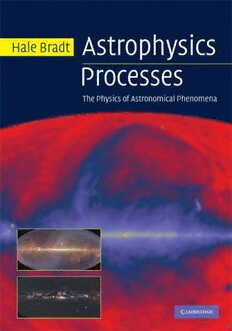
Astrophysics processes: the physics of astronomical phenomena PDF
Preview Astrophysics processes: the physics of astronomical phenomena
P1:RPU/... P2:RPU 9780521846561agg.xml CUFX241-Bradt October10,2007 14:6 ASTROPHYSICS PROCESSES Bridgingthegapbetweenphysicsandastronomytextbooks,thisbookprovidesphysical explanationsoftwelvefundamentalastrophysicalprocessesunderlyingawiderangeof phenomenainstellar,galactic,andextragalacticastronomy.Thebookhasbeenwritten forupper-levelundergraduatesandgraduatestudents,anditsstrongpedagogyensures solidmasteryofeachprocessandapplication.Itcontainstutorialfiguresandstep-by- stepmathematicalandphysicaldevelopmentwithrealexamplesanddata.Topicscov- eredincludetheKepler–Newtonproblem,stellarstructure,radiationprocesses,special relativityinastronomy,radiopropagationintheinterstellarmedium,andgravitational lensing.ApplicationspresentedincludeJeanslength,Eddingtonluminosity,thecooling of the cosmic microwave background (CMB), the Sunyaev–Zeldovich effect, Doppler boosting in jets, and determinations of the Hubble constant. This text is a stepping stonetomorespecializedbooksandprimaryliterature.Reviewexercisesallowstudents to monitor their progress. Password-protected solutions are available to instructors at www.cambridge.org/9780521846561. Hale Bradt isProfessorEmeritusofPhysicsattheMassachusettsInstituteofTech- nology (MIT). During his 40 years on the faculty, he carried out research in cosmic rayphysicsandx-rayastronomyandtaughtcoursesinphysicsandastrophysics.Bradt founded the MIT sounding rocket program in x-ray astronomy and was a senior or principalinvestigatoronthreemissionsforx-rayastronomy.HewasawardedtheNASA ExceptionalScienceMedalforhiscontributionstoHEAO-1(High-EnergyAstronomical Observatory)aswellasthe1990BuechnerTeachingPrizeoftheMITPhysicsDepart- mentandsharedthe1999BrunoRossiprizeoftheAmericanAstronomicalSocietyfor his contributions to the RXTE (Rossi X-ray Timing Explorer) program. His previous book, Astronomy Methods: A Physical Approach to Astronomical Observations, was publishedbyCambridgeUniversityPressin2004. i P1:RPU/... P2:RPU 9780521846561agg.xml CUFX241-Bradt October10,2007 14:6 Coverinformation Viewsoftheentireskyatsixwavelengthsingalacticcoordinates;theequatoroftheMilky Waysystemisthecentralhorizontalaxisandthegalacticcenterdirectionisatthecenter. Exceptforthefarinfraredx-raysky,thecolorsrepresentintensitywiththegreatest intensitieslyingalongtheequator.Inallcases,theradiationshowsanassociationwiththe galacticequator,thegeneraldirectionofthegalacticcenter,orboth.Themapsarein frequencysequenceaslistedhere:toptobottomonthebackcoverfollowedonthefront coverbytopinset,backgroundmap,lowerinset. Radioskyat408Hzexhibitingadiffuseglowofsynchrotronradiationfromtheentire sky.High-energyelectronsspiralinginthemagneticfieldsoftheGalaxyemitthisradiation. NotetheNorthPolarSpurprojectingabovetheequatortotheleftofcenter.Fromthree observatories:JodrellBank,MPIfR,andParkes.[GlynHaslametal.,MPIfR,SkyView] Radioemissionat1420MHz,thespin-flip(hyperfine)transitioninthegroundstateof hydrogen,whichshowsthelocationsofcloudsofneutralhydrogengas.Thegasisheavily concentratedinthegalacticplaneandmanifestspronouncedfilamentarystructureoffthe plane.[J.Dickey(UMn),F.Lockman(NRAO),SkyView;ARAA28,235(1990)] Farinfrared(60–240µm)skyfromtheCOBEsatelliteshowingprimarilyemissionfrom smallgrainsofgraphiteandsilicates(“dust”)intheinterstellarmediumoftheGalaxy.The faint,largeS-shapedcurve(onitsside)isemissionfromdustandrocksinthesolarsystem; reflectionofsolarlightfromthismaterialcausesthezodaicallightatopticalwavelengths. Colorcoding:60µm(blue),100µm(green),240µm(red).[E.L.Wright(UCLA),COBE, DIRBE,NASA] Opticalskyfromamosaicof51wide-anglephotographsshowingmostlystarsinour MilkyWayGalaxywithsignificantextinctionbydustalongthegalacticplane.Galaxiesare visibleathighergalacticlatitudes,themostprominentbeingthetwonearbyMagellanic Clouds(lowerright).[(cid:2)CAxelMellinger] X-rayskyat1–20keVfromtheA1experimentontheHEAO–1satelliteshowing842 discretesources.Thecirclesizerepresentsintensityofthesource,andthecolordenotesthe typeofobject.Themostintensesourcesshown(green,largercircles)signifycompact binarysystemscontainingwhitedwarfs,neutronstars,andblackholes.Otherobjectsare supernovaremnants(blue),clustersofgalaxies(pink),activegalacticnuclei(orange),and stellarcoronae(white).[KentWood,NRL;seeApJSuppl.56,507(1984)] Gamma-rayskyabove100MeVfromtheEGRETexperimentontheCompton Gamma-RayObservatory.Thediffuseglowfromthegalacticequatorisduetothe collisionsofcosmic-rayprotonswiththeatomsofgasclouds;thenuclearreactionsproduce thedetectedgammarays.Discretesourcesincludepulsarsandjetsfromdistantactive galaxies(“blazars”).[TheEGRETteam,NASA,CGRO] ii P1:RPU/... P2:RPU 9780521846561agg.xml CUFX241-Bradt October10,2007 14:6 ASTROPHYSICS PROCESSES HALE BRADT MassachusettsInstituteofTechnology iii P1:RPU/... P2:RPU 9780521846561agg.xml CUFX241-Bradt October10,2007 14:6 cambridge university press Cambridge,NewYork,Melbourne,Madrid,CapeTown,Singapore,Sa˜oPaulo CambridgeUniversityPress TheEdinburghBuilding,CambridgeCB28RU,UK PublishedintheUnitedStatesofAmericabyCambridgeUniversityPress,NewYork www.cambridge.org (cid:2)C H.Bradt2008 Thispublicationisincopyright.Subjecttostatutoryexception andtotheprovisionsofrelevantcollectivelicensingagreements, noreproductionofanypartmaytakeplacewithout thewrittenpermissionofCambridgeUniversityPress. Firstpublished2008 PrintedintheUnitedKingdomattheUniversityPress,Cambridge AcatalogrecordforthispublicationisavailablefromtheBritishLibrary. LibraryofCongressCataloginginPublicationData Bradt,Hale,1930– Astrophysicsprocesses/HaleBradt. p. cm. Includesbibliographicalreferencesandindex. ISBN978-0-521-84656-1(hardback) 1.Astrophysics. I.Title. QB461.B67 2008 523.01–dc22 2007031649 ISBN 978-0-521-84656-1hardback CambridgeUniversityPresshasnoresponsibilityforthepersistenceor accuracyofURLsforexternalorthird-partyinternetwebsitesreferredto inthispublication,anddoesnotguaranteethatanycontentonsuch websitesis,orwillremain,accurateorappropriate. iv P1:RPU/... P2:RPU 9780521846561agg.xml CUFX241-Bradt October10,2007 14:6 To mythreesisters, Val,Abby,andDaleAnne TheyaremyfansandItheirs v P1:RPU/... P2:RPU 9780521846561agg.xml CUFX241-Bradt October10,2007 14:6 vi P1:RPU/... P2:RPU 9780521846561agg.xml CUFX241-Bradt October10,2007 14:6 Contents Listoffigures pagexv Listoftables xx Preface xxi Alsobytheauthor xxv Acknowledgments xxvii 1 Kepler, Newton, and the mass function 1 1.1 Introduction 2 1.2 Binarystarsystems 2 (cid:2) (cid:2) (cid:2) Celestiallaboratories Visualbinaries Eclipsingbinaries Spectroscopicbinaries 1.3 KeplerandNewton 9 Kepler’slaws(M≫m) (cid:2)Ellipse (cid:2)TheNewtonianconnection (cid:2) Earth-orbitingsatellites–Orbitchange–Launchinclination 1.4 NewtoniansolutionsM≫m 15 (cid:2) (cid:2) Componentsoftheequationofmotion Angularmomentum(KeplerII) Ellipticalmotion(KeplerI)–Trialsolutiontransformed–Radialequation transformed–Solution (cid:2)Angularmomentumrestated (cid:2)Periodand (cid:2) semimajoraxis(KeplerIII) Totalenergy 1.5 Arbitrarymasses 22 Relativemotions–Relativecoordinates:reducedmass–Equationofmotion– EquivalencetotheM ≫mproblem (cid:2)Solutions–Angularmomentum– Ellipticalmotion–Periodandsemimajoraxis(KeplerIII)–Totalenergy 1.6 Massdeterminations 28 Massfunction (cid:2)Stellarmassesfromcircularorbits–Massivecentralobject– Circularorbits–Spectroscopicbinary (cid:2)Stellarmassesfromellipticalorbits– Orbitalelements–Visualbinary:relativeorbit–Visualbinary:twoorbits– Spectroscopicbinary–MassofablackholeinCygnusX-1–Massesof neutron-starpulsars vii P1:RPU/... P2:RPU 9780521846561agg.xml CUFX241-Bradt October10,2007 14:6 viii Contents 1.7 Exoplanetsandthegalacticcenter 39 Exoplanets (cid:2)Galacticcenter–Stellarorbits–Distancetothegalacticcenter– Massiveblackhole 2 Equilibrium in stars 49 2.1 Introduction 50 2.2 Jeanslength 50 (cid:2) Collapsecriterion Criticalmass 2.3 Hydrostaticequilibrium 52 (cid:2) Balancedforces Pressuregradient 2.4 Virialtheorem 54 Potentialandkineticenergies (cid:2)Derivation (cid:2)Stars (cid:2)Clustersofgalaxies– Spatialdistribution–VirialMass 2.5 Timescales 59 Thermaltimescale (cid:2)Dynamicaltimescale (cid:2)Diffusiontimescale– One-dimensionalrandomwalk–Three-dimensionalwalk–Meanfreepath– Solarluminosity 2.6 Nuclearburning 65 Stableequilibrium–Coulombbarrier–Nuclearwarmer (cid:2)Proton-proton(pp) chain–Nuclearinteractions–Baryon,lepton,andchargeconservation–Energy conservation–pep,hep,andBereactions (cid:2)CNOcycle (cid:2)Energyproduction– Yieldpercycle–Sunlifetime–Energy-generationfunction 2.7 Eddingtonluminosity 73 Forcesonchargedparticles–Radiativeforce–Balancedforces (cid:2)Maximum starmass (cid:2)Massaccretionrate–Neutron-staraccretion–Accretion luminosity–Massiveblackholes 2.8 Pulsations 78 Heatengine (cid:2)Conditionforpulsations (cid:2)Ionizationvalve–Transitionzone– Variablesasdistanceindicators 3 Equations of state 87 3.1 Introduction 88 3.2 Maxwell–Boltzmanndistribution 89 One-dimensionalgas (cid:2)Three-dimensionalgas–Maxwell–Boltzmann distribution–Momentumspace–Distributionofmomentummagnitude 3.3 Phase-spacedistributionfunction 92 (cid:2) (cid:2) Maxwell–Boltzmannin6-Dphasespace Measurablequantities Specific intensity–Particlenumber–Energyandphotons–Liouville’stheorem– Conservationofspecificintensity–Relativityconnection P1:RPU/... P2:RPU 9780521846561agg.xml CUFX241-Bradt October10,2007 14:6 Contents ix 3.4 Idealgas 97 Particlepressure–Momentumtransfer–Averagekineticenergy (cid:2)Equation ofstate–Physicalform–Macroscopicform(idealgaslaw) 3.5 Photongas 101 3.6 Degenerateelectrongas 102 Fermionsandbosons–Spin–Pauliexclusionprinciple–Degeneracy– Statisticsanddistributionfunctions (cid:2)One-dimensionaldegeneracy–Plotsof 2-Dphasespace–Fermimomentum–Compressionandcooling–Temperature (cid:2)Three-dimensionaldegeneracy–Fermimomentum–Fermifunction–Fermi energy–Pressuresofelectronsandprotons (cid:2)NonrelativisticEOS–Average kineticenergy–Pressure (cid:2)RelativisticEOS (cid:2)SummaryofEOS 4 Stellar structure and evolution 117 4.1 Introduction 118 4.2 Equationsofstellarstructure 118 Fundamentalequations–Hydrostaticequilibrium–Massdistribution– Luminositydistribution–Radiationtransport (cid:2)Convectivetransport– Conditionforconvection–Adiabatictemperaturegradient (cid:2) Secondary equations 4.3 Modelingandevolution 124 Approachtosolutions (cid:2)Sun (cid:2)Main-sequencestars–Spectraltypes– Convectiveregions (cid:2)Hertzsprung–Russelldiagram–Color-magnitude diagram–Effectivetemperatureandradius (cid:2)Giantsandsupergiants (cid:2) Evolutionofsinglestars–Solarevolution–Massivestars–Gamma-ray bursts–Globularclusters–Openclusters–Variablestars (cid:2)Scalinglaws– Matterdensity–Pressure–Temperature–Luminosity–Massdependence– H-Rdiagramcomparison–Homologytransformations 4.4 Compactstars 142 Whitedwarfs–Mass-radiusrelation–Stability–SiriusB–Chandrasekhar masslimit (cid:2)Neutronstars–Radiusofaneutronstar–Equationsofstateand structure–Evidenceforneutronstars–Maximummass (cid:2)Blackholes–Event horizon(Schwarzschildradius)–Angularmomentum–Innermoststableorbit– Broad,distortedironline–Plancklength–Particleacceleration–Evaporation– Existenceofblackholes 4.5 Binaryevolution 157 Timescales (cid:2)Gravitationalradiation–Energylossrate–Finalchirp (cid:2)Tidal interaction (cid:2)Magneticbreaking (cid:2)Effectiveequipotentials–Rochelobes– Lagrangian-pointpositions (cid:2)Accretion–Starseparation–Periodchange– Stellarwinds–Pulsarwindandx-rayirradiation (cid:2)Suddenmassloss– Semimajoraxisandperiod–Eccentricity–Unbindingoftheorbit (cid:2) Evolutionaryscenarios–High-massx-raybinaryandbinaryradiopulsar– Pulsarevolution–Low-massx-raybinary (cid:2)Neutron-starspinup P1:RPU/... P2:RPU 9780521846561agg.xml CUFX241-Bradt October10,2007 14:6 x Contents 5 Thermal bremsstrahlung radiation 181 5.1 Introduction 182 5.2 Hotplasma 183 5.3 Singleelectron-ioncollision 185 Radiationbasics–Radiatedelectricvector–Poyntingvector–Larmor’s formula (cid:2)Energyradiatedpercollision (cid:2)Frequencyoftheemittedradiation 5.4 Thermalelectronsandasingleion 190 Single-speedelectronbeam–Powerfromtheannulus–Powerperunit frequencyinterval (cid:2)Electronsofmanyspeeds 5.5 Spectrumofemittedphotons 193 Volumeemissivity–Multipleiontargets–Exponentialspectrum–Gaunt factor–HIIregions,andclustersofgalaxies (cid:2)Integratedvolumeemissivity– Totalpowerradiated–Whitedwarfaccretion 5.6 Measurablequantities 199 Luminosity (cid:2)Specificintensity(resolvedsources)–Emissionmeasure– DeterminationofTandEM (cid:2)SpectralfluxdensityS(pointsources)– Uniformvolumeemissivity–Specificintensityandfluxdensitycompared 6 Blackbody radiation 205 6.1 Introduction 205 6.2 Characteristicsoftheradiation 208 Specificintensity–Rayleigh–JeansandWienapproximations–Peak frequency–Wavelengthunits (cid:2)Luminosityofaspherical“blackbody”– Energyfluxdensitythroughafixedsurface–Effectivetemperature (cid:2)Radiation densities–Energydensity–Spectralnumberdensity–Cellsinphasespace– Totalnumberdensity–Averagephotonenergy (cid:2)Radiationpressure–Beamof photons–Momentumtransfer–Photonpressure (cid:2)Summaryofcharacteristics (cid:2)Limitsofintensity–Particlesadded–Surfaceoflastscatter–Temperature limit–Blackandgraybodies 6.3 Cosmologicalexpansion 222 Adiabaticexpansion–Photons–Comparisonwithparticles (cid:2)Roomof recedingmirrors–Hubbleexpansionandfundamentalobservers–Reflections frommirrors–Wavelengthandroomsize (cid:2)Spectralevolution–Number spectraldensity–Temperatureandintensity 6.4 Mathematicalnotes 230 (cid:2) Riemannzetafunction Rootsofatranscendentalequation 7 Special theory of relativity in astronomy 233 7.1 Introduction 234 7.2 Postulatesofspecialrelativity 234
